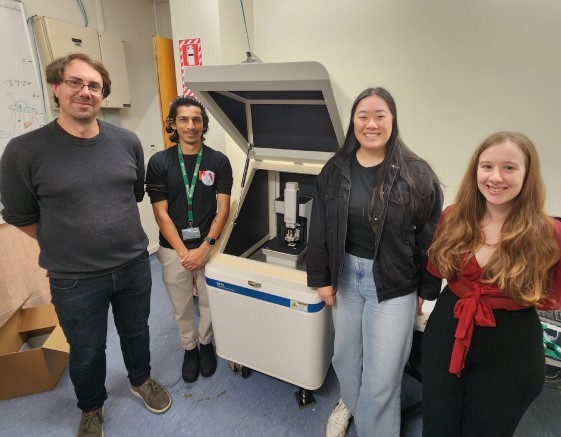NanoScientific Interview with Dr. Kim Mckelvey
- 12 Jun 2023
- Volume 24
- NANOscientific Magazine, Spring 2023

Dr. McKelvey has a diverse background in mathematics, software engineering, physical chemistry, and electrochemistry. He obtained his bachelor’s and master’s degrees in computational modelling from the University of Otago, New Zealand. He designed artificial intelligence and physical simulation solutions for 3D character animation at NaturalMotion. Subsequently, he completed his PhD in Electrochemistry & Interfaces Group at the University of Warwick, UK. His research interests involve studying the impact of nanoscale structure on electrocatalytic reactions and developing experimental techniques to make nanoscale electrochemical measurements. Dr. McKelvey is also involved in integrating nanostructure into energy storage and conversion technologies that are essential for transitioning to a low-carbon economy. He has held various positions in universities in the UK, USA, and New Zealand, and currently works as a Senior Lecturer at Victoria University of Wellington.
NS: Dr. McKelvey, congratulations on your recent outstanding publication on Nature related to electrochemical charge storage mechanism with MXene. Furthermore, you have an impressively diverse academic and professional background. How have these experiences influenced your research interests in electrochemistry and nanoscale structures?
McKelvey: Thank you. I’ve always worked at the interface between industry and academia or between different disciplines. Electrochemistry involves oxidation or reduction reactions at a solid-liquid interface, and so I am again working at an interface. I am interested in electrochemistry because it has so many exciting applications, from batteries to supercapacitors, fuel cells and powerto-X technologies, that are central to using renewable electrical energy for the transition to a low-carbon world.
NS: What experimental techniques have you developed to make nanoscale electrochemical measurements, and what challenges have you faced in implementing them?
McKelvey: I have been involved in developing several new techniques for mapping chemical and electrochemical reactions at the nanoscale. These include Intermittent Contact-Scanning Electrochemical Microscopy, dual-electrode and quadruple electrode scanning probes, surfacecharge mapping using Scanning Ion Conductance Microscopy, and Bias Modulated Scanning Ion Conductance Microscopy. I have been involved in the development of Scanning Electrochemical Cell Microscopy (SECCM) starting during my time at the University of Warwick working with the brilliant Professor Pat Unwin. In terms of challenges for developing new experimental scanning probe approaches, the first one is probe fabrication. Ideally you want an approach where the probes are simple and quick to fabricate. The second challenge is data interpretation. When developing a new experimental electrochemical technique, you need to understand what your electrochemical signal means and what this says about the underlying chemical reactions that are happening at the sample surface.
NS: What principal tools do you use for your nanoscale electrochemistry research and how are they used?
McKelvey: There are multiple ways to make electrochemical measurements at the nanoscale, from nano impact measurements of single nanoparticles to resistive pulse sensing. The key to all these approaches is being able to restrict the measurement to a nanoscale domain either in space or time. The principal tool I use is Scanning Electrochemical Cell Microscopy. This approach uses a very small droplet at the end of a probe to restrict measurements to very small regions of a sample surface. Scanning Electrochemical Cell Microscopy has proved to be very versatile, and I am still discovering new things we can use this approach for.
NS: What inspired you to conduct nanoscale electrochemical measurements in this unique experimental configuration, and what challenges did you face during the experiment?
McKelvey: MXene materials have many interesting electrochemical applications. But MXenes have typically been studied on a large scale, with many individual MXene flakes studied at the same time. We asked ourselves what the intrinsic pseudocapacitive response of a MXene surface was and if we could measure it. Using a Scanning Electrochemical Cell Microscopy approach, we isolated the pseudocapacitive response from a single monolayer flake of MXene. The key challenge we faced in doing these measurements was locating an appropriate single monolayer flake on our sample surface.
NS: How do you see the field of electrocatalysis evolving in the next 5-10 years, and what potential breakthroughs or advancements do you anticipate in this area?
McKelvey: Electrolysis technologies are central to reaching zero-carbon, allowing synthesis of chemical products and liquid fuels from renewable electrical energy. With the dropping price of renewable electrical energy, I hope electrolysis technologies (which incorporate nanostructured electrodes) become cost competitive to existing fossil-fuels derived products in the next 10 years. After which, I would hope to see the rapid adoption of electrolysis technologies for the synthesis of a wide range of chemical commodities.